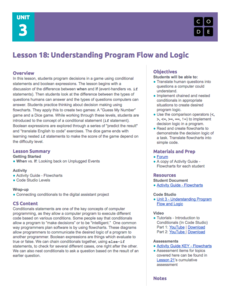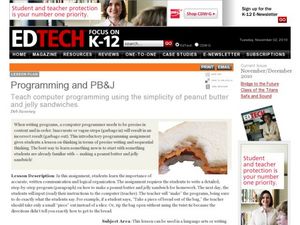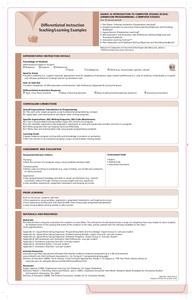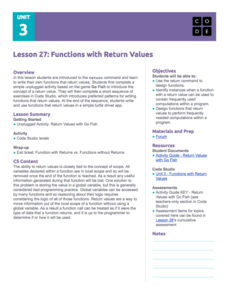National Woman's History Museum
Getting with the Program
A seven-step lesson introduces the emergence of computer sciences and the contributions women made to the profession after World War II. Several science experiments offer pupils a hands-on learning experience that showcases parabolas,...
Curated OER
Linear Programming
Students explore inequalities to determine the optimal solution to maximize a profit for a company. In this linear programming lesson, students discover how to graph inequalities and how to determine the algebraic representation of a...
Code.org
Understanding Program Flow and Logic
Explore decision-making logic in programming computer games. The 10th installment of a 21-part unit teaches scholars how to apply conditional statements and Boolean expressions. They use these concepts to create a "Guess My Number" game...
Curated OER
Alice Computer Programming
Middle schoolers explore multimedia components. In this science inquiry lesson, students read "Invitation to the Game" by Monica Hughes and they use the Alice Computer Programming System to better understand population dynamics.
Google
Adventure on the High Seas
Ahoy there! A fun computer science lesson challenges pupils to write a program that creates an ocean wave. They then develop stories to accompany their projects. All of this takes place within the Scratch coding program.
Curated OER
Programming and PB&J
Students use peanut butter and jelly sandwiches as a method for learning computer programming skills. For this computer programming lesson, students write a detailed, step-by-step program for how to make a peanut butter and jelly...
Curated OER
Computer Programming: Learning Alice Programming
Students examine the Alice Program. In this computer programming lesson, students use the drag and drop program method and view a PowerPoint presentation. Students will then create a snowman by using the drag and drop method.
Curated OER
Programming with Alice
Students develop their technology skills. In this computer programming lesson, students use Alice software to complete programming tasks and ultimately to program a video game or movie.
Curated OER
TECH:Introduction to Programming (IT)
Learners complete an activity that illustrates the concepts of giving accurate instructions and computer programming. They also identify the relationship of the instructions/code to computer programming. Students then create a peanut...
Curated OER
Problem Solving in Computer Classrooms
Pupils discuss and implement basic problem solving techniques. They define program specifications and write programs. Students work cooperatively on programming problems and brainstorm solutions.
TryEngineering
Program Your Own Game
Young computer scientists get to see what it's like to be a software engineer as they use free online software to design a computer game. They play and evaluate games groups created to round out the activity.
Code.org
Introduction to Arrays
How can you store lists in a computer program? The 16th installment of a 21-part unit introduces arrays as a way to store lists within a variable. Individuals program a list of their favorite things—adding interest to the activity.
Ontario
Animation Programming—Computer Studies
Introduce high schoolers interested in animation programming to fundamental programming concepts so that they can plan and write simple programs.
Code.org
Functions with Return Values
Young computer scientists explore how to use the return command in computer programing by playing Go Fish. They learn about functions that return values and then write a turtle driver app using the return function.
Microsoft
Events and Event-Driven Programming
Make the lesson an event to remember. The first of nine installments in the Intro to CS with MakeCode series looks at events and event handlers in computer coding. Pupils learn about cause and effect from an offline lesson, then use...
Code.org
The Need for Programming Languages
LEGO see if you can recreate my design. Individuals build an arrangement from LEGO blocks and write directions for someone else to follow in order to recreate the arrangement. Pairs then swap directions and try to...
Code.org
Event-Driven Programming and Debugging
Start programming in event-driven style. Scholars learn to place buttons on the user interface and use event handlers. They also learn to recognize errors in code and debug as necessary. This is the second lesson in the series of 21.
Curated OER
ASL: Lesson 15
ASL is fun to learn and now so easy! This is lesson 15 in a series of 30+ lessons of learning or teaching ASL in a comprehensible and strategic way. Use this lesson to reinforce identifying community helpers and conducting an interview....
Curated OER
Computer Tracks Lunch Choices
Students read a story called Computer Program Tracks Lunch Choices and answer vocabulary and comprehension questions about it. In this current events literacy lesson plan, students respond to literature by answering questions, recalling...
Code.org
Events Unplugged
Introduce event-driven programming. Young computer scientists learn the meaning of event-driven programming and how it is different from previous styles of programming. They play a card game to simulate the challenges that occur in this...
Code.org
Image Scroller with Key Events
Discover how to embed images in lists. Scholars modify an existing app to include an image scroller in the 17th lesson of the series. They learn to refactor code and remove redundancies after modifying code.
Curated OER
ASL: Lesson 5
Sign language is an effective way to communicate with those special needs, hearing, impaired, and non-verbal pupils. This lesson provides a highly structured way to learn or teach ASL. Included are multiple links to images, descriptions,...
Curated OER
"It's More Than a School": Proposing Programs to Meet Student Needs
This detailed lesson plan from New York Times' The Learning Network centers around Carroll Academy and its girl's basketball team. Learners compare their school to Carroll Academy, read anywhere from 1 to 5 engaging articles about the...
Curated OER
Irregularly Scheduled Programming
Students examine their favorite holidays and how they are celebrated. After reading an article, they discuss the length of television programming for the Super Bowl. In groups, they create their own television programming relating to...























